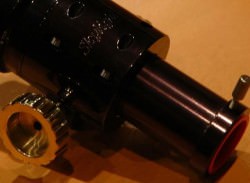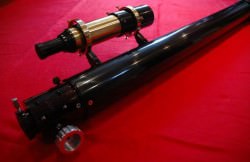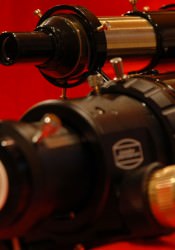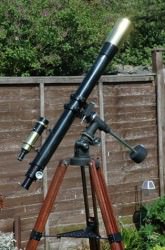[/caption]
What you’re looking at isn’t a vintage telescope, but a modern day long focus refractor. Custom-built to exacting standards, this new twist on an old breed doesn’t make you one of the crowd… it makes you stand out in one.
Drive your car down the highway and how long does it take to spot a model that’s the same as yours? Get that new look in clothes and sure enough you’ll catch someone wearing the same shirt. When it comes to telescopes, walk through any star party and you’re sure to find a piece of equipment identical to what you own. Why not turn having a telescope into an ultra personal experience by choosing a one that’s totally unique? A Skylight Telescopes Custom Refractor can do that for you.
 Hand-crafted and inspired directly by telescopes designed in the 19th Century, Skylight Custom Refractors show attention to detail and craftsmanship that are simply unsurpassed. They are the brainchild of Richard Day. “Being surrounded by interesting refractors made me a little jaded towards modern telescopes and the fairly obvious similarities found from brand to brand. I was particularly captivated by the beautiful refractors made by T. Cooke and Sons… not very well known in the USA, but revered in the UK and Europe.” says Day. “While stepping back and appreciating a particularly nice 3″/f15 example, I had a ‘why doesn’t anyone make anything like this anymore?’ moment, and so I decided that I would.”
Hand-crafted and inspired directly by telescopes designed in the 19th Century, Skylight Custom Refractors show attention to detail and craftsmanship that are simply unsurpassed. They are the brainchild of Richard Day. “Being surrounded by interesting refractors made me a little jaded towards modern telescopes and the fairly obvious similarities found from brand to brand. I was particularly captivated by the beautiful refractors made by T. Cooke and Sons… not very well known in the USA, but revered in the UK and Europe.” says Day. “While stepping back and appreciating a particularly nice 3″/f15 example, I had a ‘why doesn’t anyone make anything like this anymore?’ moment, and so I decided that I would.”
 From conception to finished product took Richard two years, but the end result quickly captivated the UK publication, Astronomy Now. “This telescope delivers a serious optical punch. Star testing under calm conditions at 187x showed nearly identical diffraction rings inside and outside focus. In focus, stars displayed a hard Airy disc with a pair of textbook perfect diffraction rings round them. I’m happy to report a cautious 1/8 wave for this optic. I could not detect coma, field curvature, astigmatism or distortion.” says Neil English. “The last quarter moon was mind-boggling. I had to charge the telescope with stupendously high powers (about 100x per inch) before any image breakdown manifested itself. At these excessive powers, image quality was still very good, with only mere traces of yellow and blue tinges visible around crater rims at areas of high contrast.”
From conception to finished product took Richard two years, but the end result quickly captivated the UK publication, Astronomy Now. “This telescope delivers a serious optical punch. Star testing under calm conditions at 187x showed nearly identical diffraction rings inside and outside focus. In focus, stars displayed a hard Airy disc with a pair of textbook perfect diffraction rings round them. I’m happy to report a cautious 1/8 wave for this optic. I could not detect coma, field curvature, astigmatism or distortion.” says Neil English. “The last quarter moon was mind-boggling. I had to charge the telescope with stupendously high powers (about 100x per inch) before any image breakdown manifested itself. At these excessive powers, image quality was still very good, with only mere traces of yellow and blue tinges visible around crater rims at areas of high contrast.”
 With all of this comes a price – and Skylight Refractors don’t come cheap. But, there is a reason. Each one of these unique telescopes is custom built and quality optics are expensive. Only through mass production can a telescope company lower their prices and Richard isn’t a company… he’s an artisan. “Victorian design is now virtually lost in favour of mass produced, CNC machined white tubes, which I simply do not find terribly interesting.” says Day. “The Victorian design element is an exercise in elegance for me…many people have told me that my scopes are the most beautiful that they’ve ever seen, and this pleases me greatly.”
With all of this comes a price – and Skylight Refractors don’t come cheap. But, there is a reason. Each one of these unique telescopes is custom built and quality optics are expensive. Only through mass production can a telescope company lower their prices and Richard isn’t a company… he’s an artisan. “Victorian design is now virtually lost in favour of mass produced, CNC machined white tubes, which I simply do not find terribly interesting.” says Day. “The Victorian design element is an exercise in elegance for me…many people have told me that my scopes are the most beautiful that they’ve ever seen, and this pleases me greatly.”
 Originally a Vancouver native, Richard takes his telescope making seriously. Every telescope he designs is individually star tested from his London home, then signed and numbered before they are released. With the exception of the focuser and optics, it’s all handcrafted and when each limited number of a model is gone? It’s gone forever. Because of their exclusive nature, Skylight Refractors were never meant to be offered “wholesale” – but now a few of them are available around the world. Where can they be found? In Europe, it’s Skylight Telescopes. In Canada, it’s Vancouver Telescope Centre or Khan Scope Centre. In the United States, it’s from my home-zone, OPT.
Originally a Vancouver native, Richard takes his telescope making seriously. Every telescope he designs is individually star tested from his London home, then signed and numbered before they are released. With the exception of the focuser and optics, it’s all handcrafted and when each limited number of a model is gone? It’s gone forever. Because of their exclusive nature, Skylight Refractors were never meant to be offered “wholesale” – but now a few of them are available around the world. Where can they be found? In Europe, it’s Skylight Telescopes. In Canada, it’s Vancouver Telescope Centre or Khan Scope Centre. In the United States, it’s from my home-zone, OPT.
 When Skylight Refractors appeared at the 2011 NEAF gathering in Rockland, New York, it was all one could do to not want to take one home… permanently. Quite simply put, they are that beautiful and well-constructed. Lunar and planetary observing, double stars… You’re no longer just observing by rote, but practicing a time-honored craft. Just imagine yourself owning a telescope that matches the caliber of those used by the Cambridge Observatory, Coats Observatory, Carter Observatory or Yorkshire Philosophical Society. So enduring was this design that many are still in use today. Be assured that owning a classic telescope is like owning your own personal piece of history – one that will be around long after fancy has faded. I cannot thank Richard enough for allowing me to take a personal look at – and interest in – what he has to offer.
When Skylight Refractors appeared at the 2011 NEAF gathering in Rockland, New York, it was all one could do to not want to take one home… permanently. Quite simply put, they are that beautiful and well-constructed. Lunar and planetary observing, double stars… You’re no longer just observing by rote, but practicing a time-honored craft. Just imagine yourself owning a telescope that matches the caliber of those used by the Cambridge Observatory, Coats Observatory, Carter Observatory or Yorkshire Philosophical Society. So enduring was this design that many are still in use today. Be assured that owning a classic telescope is like owning your own personal piece of history – one that will be around long after fancy has faded. I cannot thank Richard enough for allowing me to take a personal look at – and interest in – what he has to offer.
Why sail along the stars when you can sail with them?
Addendum: This review was intended to re-kindle the romantic and personal experience which observers feel for their equipment. Make no mistake – this is a high quality refractor which employs state-of-the-art components such as high quality Japanese glass objectives in a handmade collimateable countercell and a premium Baader Steeltrack focuser. Its design allows for high magnfication – above and beyond the call of duty, and the color correction is outstanding. This is not a “model” telescope, but a telescope modeled after a time-honored design. Its performance level – like all telescopes – relies on the eyepiece introduced. Use lesser quality and you’ll get diminuished performance. Use a premium occular and you’ll get the view you paid for! And its cost, by the way, is not only comparable to similar custom made refractors (such as Stellarvue), but even less in some instances.


Advertising? =0
Your father’s telescope. This is the tool of an astronomer. Not as clumsy or random as a CNC machined white tube; an elegant tool for a more civilized age.
Reminds me of the Questar: looks good during the day, but so-so views at night. I have to say such equipment snobs/posers make me sick, but I guess every hobby has them…
see above post your post Mr Wilson!
There are three reasons to have a telescope.
1) To view or image celestial objects
2) To view or image terrestrial objects
3) To act as an object for display or collection
Of course, one can own one for more than one of these reasons
but typically one is primary. This scope is clearly in the #3
category. If that is what you want, fine. Just do not expect
great performance.
please see “addendum”. 😀
This is NOT a truly high quality piece of optics as far as I can see from the specs. The manufacturer says it is an “achromat refractor”. They say nothing more about the optics, no details, just a kinda weak “these are good” type of statement. Ads like this should set off one’s BS detectors.
The review says “mere traces of yellow and blue tinges visible around crater rims”. In other words, it suffers from chromatic aberration.
True high quality refractor optics normally come in apo form from the likes of Takahashi, Astro-Physics and a few others.
I stand by my statement. This appears to be a nice looking, kinda Victorian steam-punk refractor that has adequate but far from ideal performance. Great for the living room but if you are serious about optics and astronomy, there are better choices.
Really,,,,, Have you ever viewed the night sky in a Questar. By what you have said, NO! When you can bump a scope to max mag by size and see or photo no discernible Difference in the quality of the image then you have superb quality. When you go well above recommended mag in a scope and get the same results in image quality then you have a Questar, or a TMB or any other scope of the same quality. Oh and Questar does make a 7 1/2 inch scope also but better hit your 401k to pay for it. Some people prefer Folger’s coffee some drink Mavis Bank Certified Jamaica Blue mountain Coffee.
I own a Questar 7 and the Questar Seven has twice the resolving power, four times the light grasp and two times the effective focal length of the Questar 3.5 and have never see the sky as seen through this scope. Stars as pinpoints at well above the highest recommended power for any other scope. Snob yes so what but you are welcome to look through my scope anytime and wish you had one, yes then i’m a snob but a Poser far from it your the poser wishing you could afford one!!
😀
I agree. I remember looking though a D&G, F-15 5 inch refractor. Afterwards I spent some time using an 8 ” Meade SC. I was able to compare the view several times and while the view was a little brighter through the Meade, stars were far more pin point and the bands of Jupiter looked like the were drawn with a ruler when viewed through the refractor. And the long focal length allowed for the use of a 12.5 mm eyepiece with lots of eye relief!
In my time, I’ve looked through three Questar 3.5s, and in all cases, they were no better than the Meade ETX-90.
In terms of light grasp sure but the quality of image and ability to use extreme power there is no comparison. do the math and science, the optics are day and night. Slap a camera on and dark sky’s, what ever just guess it’s a preference.